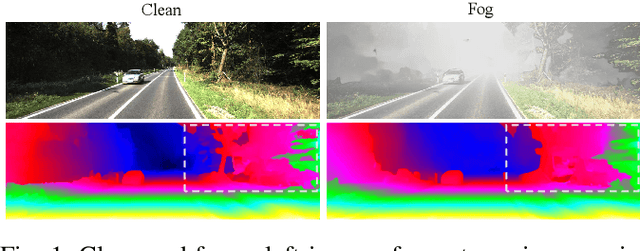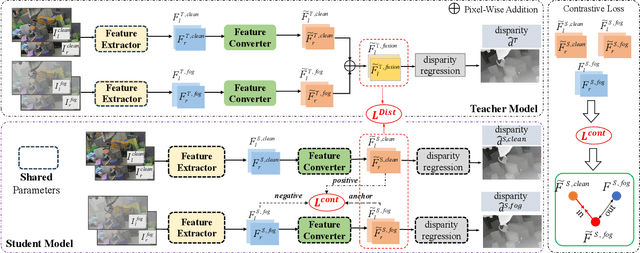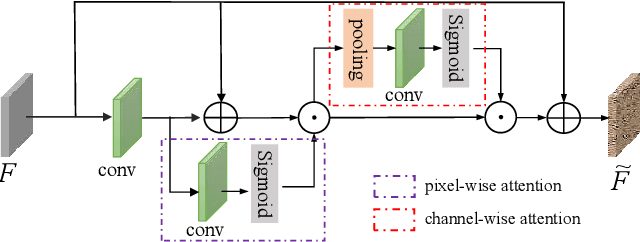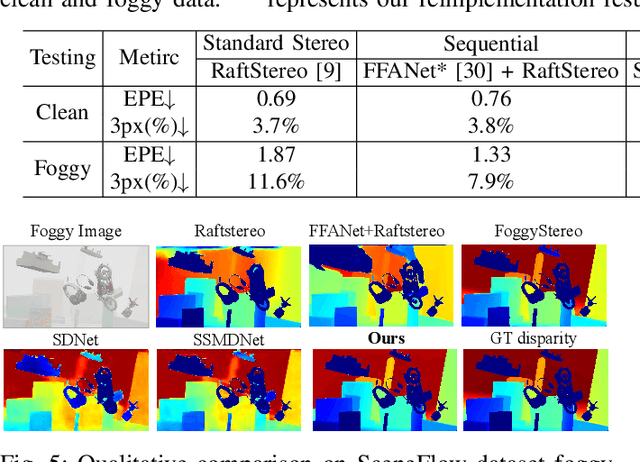Masatoshi Okutomi
Segmentation-Guided Neural Radiance Fields for Novel Street View Synthesis
Mar 18, 2025Abstract:Recent advances in Neural Radiance Fields (NeRF) have shown great potential in 3D reconstruction and novel view synthesis, particularly for indoor and small-scale scenes. However, extending NeRF to large-scale outdoor environments presents challenges such as transient objects, sparse cameras and textures, and varying lighting conditions. In this paper, we propose a segmentation-guided enhancement to NeRF for outdoor street scenes, focusing on complex urban environments. Our approach extends ZipNeRF and utilizes Grounded SAM for segmentation mask generation, enabling effective handling of transient objects, modeling of the sky, and regularization of the ground. We also introduce appearance embeddings to adapt to inconsistent lighting across view sequences. Experimental results demonstrate that our method outperforms the baseline ZipNeRF, improving novel view synthesis quality with fewer artifacts and sharper details.
TDM: Temporally-Consistent Diffusion Model for All-in-One Real-World Video Restoration
Jan 04, 2025



Abstract:In this paper, we propose the first diffusion-based all-in-one video restoration method that utilizes the power of a pre-trained Stable Diffusion and a fine-tuned ControlNet. Our method can restore various types of video degradation with a single unified model, overcoming the limitation of standard methods that require specific models for each restoration task. Our contributions include an efficient training strategy with Task Prompt Guidance (TPG) for diverse restoration tasks, an inference strategy that combines Denoising Diffusion Implicit Models~(DDIM) inversion with a novel Sliding Window Cross-Frame Attention (SW-CFA) mechanism for enhanced content preservation and temporal consistency, and a scalable pipeline that makes our method all-in-one to adapt to different video restoration tasks. Through extensive experiments on five video restoration tasks, we demonstrate the superiority of our method in generalization capability to real-world videos and temporal consistency preservation over existing state-of-the-art methods. Our method advances the video restoration task by providing a unified solution that enhances video quality across multiple applications.
Disparity Estimation Using a Quad-Pixel Sensor
Sep 01, 2024



Abstract:A quad-pixel (QP) sensor is increasingly integrated into commercial mobile cameras. The QP sensor has a unit of 2$\times$2 four photodiodes under a single microlens, generating multi-directional phase shifting when out-focus blurs occur. Similar to a dual-pixel (DP) sensor, the phase shifting can be regarded as stereo disparity and utilized for depth estimation. Based on this, we propose a QP disparity estimation network (QPDNet), which exploits abundant QP information by fusing vertical and horizontal stereo-matching correlations for effective disparity estimation. We also present a synthetic pipeline to generate a training dataset from an existing RGB-Depth dataset. Experimental results demonstrate that our QPDNet outperforms state-of-the-art stereo and DP methods. Our code and synthetic dataset are available at https://github.com/Zhuofeng-Wu/QPDNet.
Neural Radiance Fields for Novel View Synthesis in Monocular Gastroscopy
May 29, 2024



Abstract:Enabling the synthesis of arbitrarily novel viewpoint images within a patient's stomach from pre-captured monocular gastroscopic images is a promising topic in stomach diagnosis. Typical methods to achieve this objective integrate traditional 3D reconstruction techniques, including structure-from-motion (SfM) and Poisson surface reconstruction. These methods produce explicit 3D representations, such as point clouds and meshes, thereby enabling the rendering of the images from novel viewpoints. However, the existence of low-texture and non-Lambertian regions within the stomach often results in noisy and incomplete reconstructions of point clouds and meshes, hindering the attainment of high-quality image rendering. In this paper, we apply the emerging technique of neural radiance fields (NeRF) to monocular gastroscopic data for synthesizing photo-realistic images for novel viewpoints. To address the performance degradation due to view sparsity in local regions of monocular gastroscopy, we incorporate geometry priors from a pre-reconstructed point cloud into the training of NeRF, which introduces a novel geometry-based loss to both pre-captured observed views and generated unobserved views. Compared to other recent NeRF methods, our approach showcases high-fidelity image renderings from novel viewpoints within the stomach both qualitatively and quantitatively.
VSRD: Instance-Aware Volumetric Silhouette Rendering for Weakly Supervised 3D Object Detection
Mar 29, 2024Abstract:Monocular 3D object detection poses a significant challenge in 3D scene understanding due to its inherently ill-posed nature in monocular depth estimation. Existing methods heavily rely on supervised learning using abundant 3D labels, typically obtained through expensive and labor-intensive annotation on LiDAR point clouds. To tackle this problem, we propose a novel weakly supervised 3D object detection framework named VSRD (Volumetric Silhouette Rendering for Detection) to train 3D object detectors without any 3D supervision but only weak 2D supervision. VSRD consists of multi-view 3D auto-labeling and subsequent training of monocular 3D object detectors using the pseudo labels generated in the auto-labeling stage. In the auto-labeling stage, we represent the surface of each instance as a signed distance field (SDF) and render its silhouette as an instance mask through our proposed instance-aware volumetric silhouette rendering. To directly optimize the 3D bounding boxes through rendering, we decompose the SDF of each instance into the SDF of a cuboid and the residual distance field (RDF) that represents the residual from the cuboid. This mechanism enables us to optimize the 3D bounding boxes in an end-to-end manner by comparing the rendered instance masks with the ground truth instance masks. The optimized 3D bounding boxes serve as effective training data for 3D object detection. We conduct extensive experiments on the KITTI-360 dataset, demonstrating that our method outperforms the existing weakly supervised 3D object detection methods. The code is available at https://github.com/skmhrk1209/VSRD.
CFDNet: A Generalizable Foggy Stereo Matching Network with Contrastive Feature Distillation
Feb 29, 2024



Abstract:Stereo matching under foggy scenes remains a challenging task since the scattering effect degrades the visibility and results in less distinctive features for dense correspondence matching. While some previous learning-based methods integrated a physical scattering function for simultaneous stereo-matching and dehazing, simply removing fog might not aid depth estimation because the fog itself can provide crucial depth cues. In this work, we introduce a framework based on contrastive feature distillation (CFD). This strategy combines feature distillation from merged clean-fog features with contrastive learning, ensuring balanced dependence on fog depth hints and clean matching features. This framework helps to enhance model generalization across both clean and foggy environments. Comprehensive experiments on synthetic and real-world datasets affirm the superior strength and adaptability of our method.
Digging Into Normal Incorporated Stereo Matching
Feb 28, 2024Abstract:Despite the remarkable progress facilitated by learning-based stereo-matching algorithms, disparity estimation in low-texture, occluded, and bordered regions still remains a bottleneck that limits the performance. To tackle these challenges, geometric guidance like plane information is necessary as it provides intuitive guidance about disparity consistency and affinity similarity. In this paper, we propose a normal incorporated joint learning framework consisting of two specific modules named non-local disparity propagation(NDP) and affinity-aware residual learning(ARL). The estimated normal map is first utilized for calculating a non-local affinity matrix and a non-local offset to perform spatial propagation at the disparity level. To enhance geometric consistency, especially in low-texture regions, the estimated normal map is then leveraged to calculate a local affinity matrix, providing the residual learning with information about where the correction should refer and thus improving the residual learning efficiency. Extensive experiments on several public datasets including Scene Flow, KITTI 2015, and Middlebury 2014 validate the effectiveness of our proposed method. By the time we finished this work, our approach ranked 1st for stereo matching across foreground pixels on the KITTI 2015 dataset and 3rd on the Scene Flow dataset among all the published works.
Self-Supervised Spatially Variant PSF Estimation for Aberration-Aware Depth-from-Defocus
Feb 28, 2024Abstract:In this paper, we address the task of aberration-aware depth-from-defocus (DfD), which takes account of spatially variant point spread functions (PSFs) of a real camera. To effectively obtain the spatially variant PSFs of a real camera without requiring any ground-truth PSFs, we propose a novel self-supervised learning method that leverages the pair of real sharp and blurred images, which can be easily captured by changing the aperture setting of the camera. In our PSF estimation, we assume rotationally symmetric PSFs and introduce the polar coordinate system to more accurately learn the PSF estimation network. We also handle the focus breathing phenomenon that occurs in real DfD situations. Experimental results on synthetic and real data demonstrate the effectiveness of our method regarding both the PSF estimation and the depth estimation.
Reflection Removal Using Recurrent Polarization-to-Polarization Network
Feb 28, 2024Abstract:This paper addresses reflection removal, which is the task of separating reflection components from a captured image and deriving the image with only transmission components. Considering that the existence of the reflection changes the polarization state of a scene, some existing methods have exploited polarized images for reflection removal. While these methods apply polarized images as the inputs, they predict the reflection and the transmission directly as non-polarized intensity images. In contrast, we propose a polarization-to-polarization approach that applies polarized images as the inputs and predicts "polarized" reflection and transmission images using two sequential networks to facilitate the separation task by utilizing the interrelated polarization information between the reflection and the transmission. We further adopt a recurrent framework, where the predicted reflection and transmission images are used to iteratively refine each other. Experimental results on a public dataset demonstrate that our method outperforms other state-of-the-art methods.
Global Occlusion-Aware Transformer for Robust Stereo Matching
Dec 22, 2023Abstract:Despite the remarkable progress facilitated by learning-based stereo-matching algorithms, the performance in the ill-conditioned regions, such as the occluded regions, remains a bottleneck. Due to the limited receptive field, existing CNN-based methods struggle to handle these ill-conditioned regions effectively. To address this issue, this paper introduces a novel attention-based stereo-matching network called Global Occlusion-Aware Transformer (GOAT) to exploit long-range dependency and occlusion-awareness global context for disparity estimation. In the GOAT architecture, a parallel disparity and occlusion estimation module PDO is proposed to estimate the initial disparity map and the occlusion mask using a parallel attention mechanism. To further enhance the disparity estimates in the occluded regions, an occlusion-aware global aggregation module (OGA) is proposed. This module aims to refine the disparity in the occluded regions by leveraging restricted global correlation within the focus scope of the occluded areas. Extensive experiments were conducted on several public benchmark datasets including SceneFlow, KITTI 2015, and Middlebury. The results show that the proposed GOAT demonstrates outstanding performance among all benchmarks, particularly in the occluded regions.
 Add to Chrome
Add to Chrome Add to Firefox
Add to Firefox Add to Edge
Add to Edge